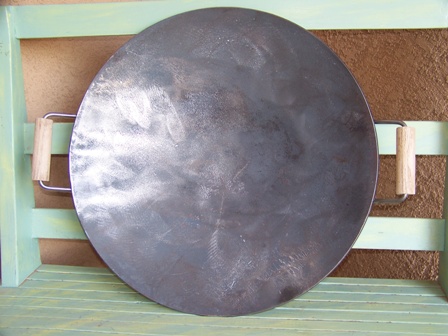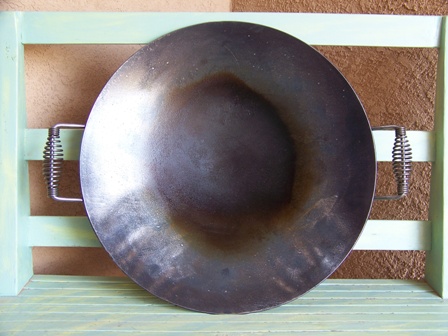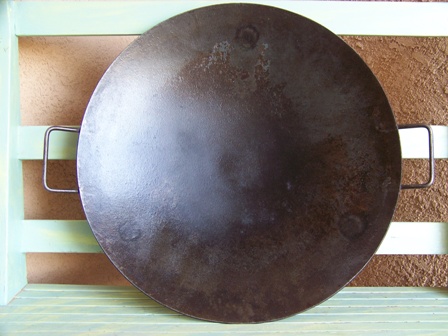Using and Caring for your DISCADA
There is really only one successful way to season a plow disk cooking utensil, and that is to use it, use it, use it!! 


Left Picture: Raw prepped plow disk
Center Picture: Initial Seasoning as delivered (Ready for first use)
Right Picture: Seasoned Disk (About a year old)
When I cook with my personal discada I use a generous coating of Extra Virgin Olive Oil. Always preheat your disk and then add your groceries…… We have provided the initial seasoning for your disk so you can use it right away. It only gets better after time and eventually you will have a very nice black seasoned disk. Be gentle with it until you build up a nice seasoned coating.
Just follow a few rules when using your disk and it will provide you with a lifetime of use!
- NEVER cook at higher heat than is necessary to do the job. The secret to disk cooking is temperature control and the good news is that it’s easy to learn.
- Always try to remember to clean the discada while it's still hot. If it cools before you get around to cleaning it, it can be reheated. Sometimes a quick shot of a pan coating like PAM and 30 seconds on the burner will work wonders. Other times, just blistering hot water from the sink faucet will suffice.
- NEVER do any more cleaning than is necessary. A quick wipe with a towel is probably going to be all that's necessary.
- If a quick wipe with a paper towel won't do the job, pour some water in the disk while it is still hot and scrub it briskly with a stiff fiber brush; stiff enough to loosen any bits and pieces off and carbonized food sticking to the pan. Remember, what you want that coating to be is carbonized oil, not carbonized groceries. When you're done put a coating of oil in it and wipe it around with a paper towel. Yes, the paper towel will be black. No, it isn't dirt. The black is carbon. Don't forget to hit the backside with oil as well every now and then.
- Avoid wire brushes like the plague and never, never use those plastic scouring pads.
- Eventually, after enough use and proper cleaning, that surface in your disc will get to be just like Teflon or Silverstone type surfaces. It will require very, very little oil for most cooking.
Until the disk is very well seasoned, either by many uses or repeated seasonings, do not attempt to cook foods with a high acid content. The corrosive nature of high-acid foods will not react well to the unseasoned disk. Once a disk is well-seasoned, however, you can use it for just about anything.
Storing – store your disk in a dry place….check out our awesome covers made by fellow Veteran Eric with Mountain Ridge Gear!
|
Bare cast-iron vessels have been used by humans for cooking for hundreds of years and your DIscada is no different in treatment (Our discs are carbon steel). The following includes examples using cast iron (ex. Dutch Ovens) and applies to the Discada as well. The Discada's ability to withstand and maintain very high temperatures makes it a natural cookware choice for searing or frying, and its excellent heat diffusion and retention makes it a natural choice for long-cooking stews like gumbo or Chili con carne. Because your Discada can develop an extremely "non-stick" surface, they are also a good choice for egg dishes, in particular scrambled eggs. Some of the types of cookware made out of bare cast iron include dutch ovens, frying pans, deep fryers, woks, potjies, and griddles. Bare cast iron cookware requires seasoning just like your DIscada—impregnation of the cooking surface with oil—to prevent rusting, and to create a non-stick surface. |


